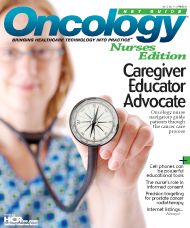Publication
Article
ONCNG Oncology Nursing
Fitness Trends for 2009
Author(s):
The editors of Health& Fitness Journal conducted an international survey of American College of Sports Medicine-certified professionals to give opinions on fitness trends for 2009.
For the past three years, the editors of Health& Fitness Journal have conducted an international survey of American College of Sports Medicine (ACSM)-certified professionals to determine their opinions on fitness trends for the coming year. More than 1,500 ACSM-certified professionals responded to the 2009 survey, the results of which should interest oncology nurses and color their approach to the topic of fitness with patients and their families. The survey results and commentary on the top fitness trends can be found online; the top five are discussed below.
Increased demand for accredited certification programs for fitness professionals
There is a pressing need for competent, trained professionals in this specialty. More colleges and universities are off ering academic degrees in exercise science, exercise physiology, and other fitness-related specialties. The ACSM and some other organizations that certify health and fitness professionals require a minimum of a bachelor’s degree for certification.
When referring patients and families to fitness professionals during or after treatment, oncology nurses should seek out fitness professionals who have experience with cancer patients. Recently, the ACSM, in collaboration with the American Cancer Society, introduced the ACSM/ACS Certified Cancer Exercise Trainer (CET) certification. A CET is qualified to work with patients who have been recently diagnosed with cancer and have not started cancer treatment, are under treatment, have completed treatment, or are survivors experiencing chronic or late effects from their disease or treatment. The CET performs appropriate fitness assessments and recommends exercise regimens based on a basic understanding of cancer diagnoses, surgeries, treatments, symptoms, and side eff ects. The minimum requirements to become a CET are outlined on the ACSM website.
Greater focus on children and obesity
Oncology nurses are well aware of the link between cancer prevention and a healthy lifestyle that includes a balanced diet and consistent exercise. Oncology nurses can participate in school and community-based programs that target you that risk for overweight and obesity, especially minorities and children of poorer families, who continue to constitute a disproportionate number of overweight and obese youth. Oncology nurses can teach children and parents about the links between healthy eating and cancer prevention. State departments of health websites offer valuable information on state-sponsored initiatives for youth obesity prevention.
Increased use of personal training
Personal trainers are a valuable source of fitness expertise. Oncology nurses can encourage patients and their families to seek out reputable personal trainers who are experienced with this population. Health insurance may not cover costs for physical therapists following cancer treatment, resulting in decreased muscle strength and flexibility. An affordable personal trainer, knowledgeable of cancer patients’ treatment and needs, can provide physical activities appropriate to the patients’ individualized needs. At-home personal training may be attractive to patients who are immunosuppressed or who live in a rural area and do not have access to a health club or organized fitness setting.
Greater emphasis on strength training
Strength training is incorporated into cardiac rehabilitation, pulmonary rehabilitation, and metabolic disease (diabetes) management. Oncology nurses know that regaining strength during and after cancer treatment is a priority for many patients. Family members, too, may neglect their own fitness needs while caring for their loved one. Oncology nurses can consult with an experienced fitness professional for specific recommendations based on their patients’ strength training needs.
Incorporating core training into fitness regimens
Core training involves the strengthening and stabilizing of the muscles of the abdomen, lower back, and shoulder girdle. Maintaining a strong core helps to prevent injuries to the back and shoulders. Strengthening muscles around the pelvis and hips promotes balance, stability, and confidence. Oncology nurses can teach core strength training to their patients by having their patients inhale deeply, and then exhale to engage the abdominal muscles and lengthen the back. Maintaining a good posture can help strengthen the core muscles too. Engaging the core muscles before lifting out of a chair, walking, or reaching can prevent lower back strains and injuries.
There are many other ways that oncology nurses can promote improved fitness in cancer patients and their families. These top five fitness trends demonstrate how everyone can benefit from simple fitness suggestions.
Lisa Marie Bernardo, PhD, MPH, RN, HFS, is an associate professor at the University of Pittsburgh School of Nursing. She is an ACSM-certified Health Fitness Specialist and ACSM/ACS Cancer Exercise Trainer and an ACSM-licensed Wellness Coach.
